I've visited quite a few cemeteries and graveyards, from pet cemeteries to Arlington in Washington, D.C. Topophilia is a hobby I enjoyed long before I began working on my family history or working in the field of genealogy. The names have always fascinated me, so much so that it should have been a clue to what my career would later become.
Growing up in Cleveland, Ohio, my family visited relatives' graves on birthdays, anniversaries, holidays, and some general weekends. Then, one day, I realized there were more cemeteries and graveyards than the ones my family was buried in.
This gothic burial ground is located on the east side of Cleveland, within walking distance of Little Italy and Coventry Street. The 285 acre cemetery is one of the oldest in the city.
While not the oldest, that title falls to Erie Street Cemetery (1826), Lake View was established in 1869, and was the first rural cemetery.
Today, this garden cemetery sits nestled among wispy, oversized trees like sycamore and tulip trees, all hidden from the busy streets surrounding it. If you didn't drive through those wrought iron gates into the rolling hills of gravestones, you would never know what treasures are held inside.
But then again, maybe you would. Maybe, like me, you find peace on cemetery lawns. If so, Lake View Cemetery is a "must-visit" attraction. With its notable interments, Cleveland's historic Lake View Cemetery stands out with its name dropping John D. Rockefeller, Elliot Ness, President Garfield, Dr. Harvey Williams Cushing, and Carl B Stokes, the first African-American mayor of a major US City, on top of everyone mentioned above, but they're not the only reason to plan a visit.
The cemetery's iconography is breathtaking. From the Garfield Memorial, to the Collinwood School Fire Memorial — Lake View Cemetery is an outdoor history museum disguised as a cemetery. Yet, beyond the history and the notable interments, there is also a scarier side to this great place. Tuck away, off the side of the main road, sits one of the most recognizable grave markers. A six foot tall bronze angel, known as the Weeping Angel.
The Weeping Angel, aka The Haserot Angel, is hauntingly beautiful statue that has captured visitors' imaginations for decades, spawning unearthly legends and terrifying ghost stories.
Some claim the Angel's eyes blink or that they've seen its head move.
Others swear they've heard crying or seen it weeping for the loss of those lying in the graves at its feet.
While I can't say I've witnessed any of these phenomena, I will say that the Haserot Angel is a spectacular example of the sculptor, Herman Matzen's, work. Other pieces seen outside the Summit, Ohio Courthouse, or the courthouse in Painesville, Ohio, the Haserot Angel is probably his most well-known. Its bronze body sits upon a seat of polished marble – both materials hand-picked by its creator, adding to its magic and mystery.
So, what is the real story of the spooky Haserot Angel, and where did it come from in the first place?
The Legend of the Weeping Angel
The Haserot Angel guards the final resting place of Francis Haserot and his wife, Sarah Henrietta McKinney Haserot. Francis Henry "Frank" Haserot was a prominent Cleveland industrialist who ran a company called Haserot Company. Haserot Company was known for canning food and as a significant importer of coffee and tea. It was well-known in the food service industry. It contributed to the city of Cleveland's growth as a commercial hub.

When Sarah died in 1919, up in Michigan, where she was receiving treatment for epilepsy, a devastated Francis transported his wife's body back to Cleveland and had her interned at Lake View. He quickly decided the flat stone marker wasn't majestic enough for his dear wife and hired Matzen to remedy the issue.
Herman Matzen completed the Angel in 1923. It over 6 feet tall, and holds an inverted torch symbolizing life extinguished. Since then, it has become a tourist attraction.
Dark streaks have formed on its face over time, captivating onlookers with its woeful expression. To many observers, these streaks resemble tears, leading to the nickname "The Weeping Angel" and fueling the rumors that the statue comes alive at night.
In reality, the "tears" are the result of natural weathering and oxidation of the bronze, but don’t let that stop you from attempting to hear it weeping at night.
The Haserot Angel is just one example of the rich symbolism found in cemeteries. A walk through Lake View Cemetery will show you many other graves displaying well-known and lesser-known cemetery symbols—but they all have a purpose and meaning.
If you have been working on your family history and visited the graves of your ancestors but walked away thinking, "Why did they put that on their grave?" Here are a few examples of graveyard symbols and what they mean.
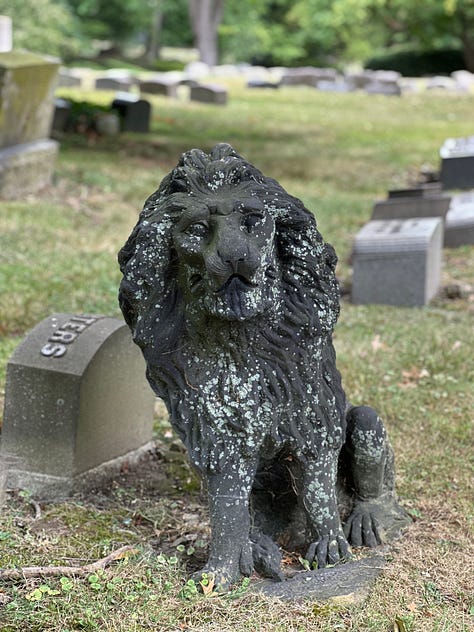
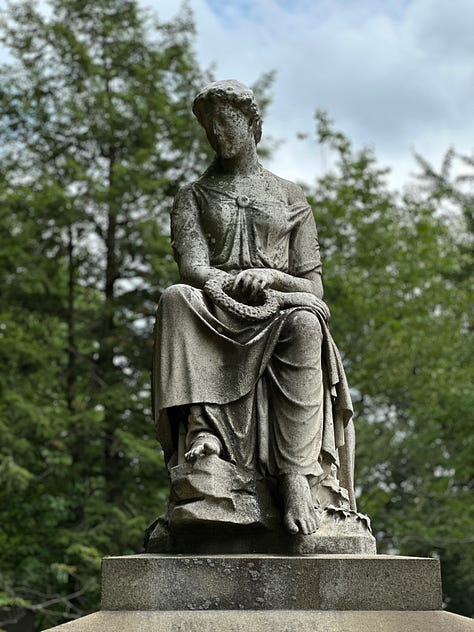
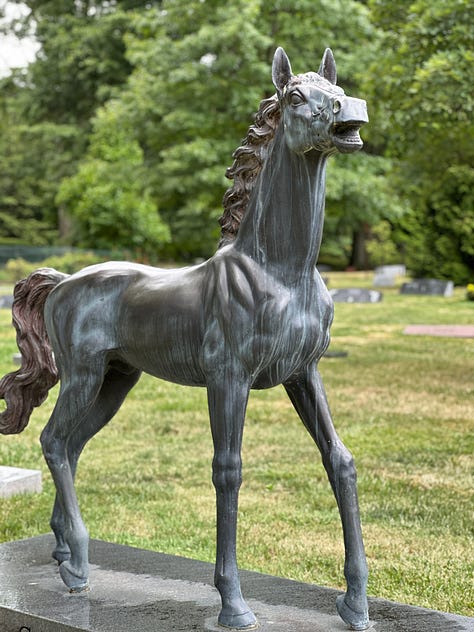
Cemetery Symbolism
Gravestone iconography has a long history, with different symbols carrying specific meanings:
Angels: Often represent guardianship, divine love, or grief
Inverted torch: Symbolizes life extinguished, but also the eternal flame of the soul
Broken column: Represents a life cut short
Clasped hands: Typically symbolize farewell or a reunion in heaven
Dove: Represents the Holy Spirit or peace
Oak leaves: Symbolize strength and endurance
Each of theses symbols help those who buried their loved ones to leave a hint of what that person meant to them. The same sentiment applies to the Haserot Angel, which shows how utterly devastated Francis Haserot was at his wife's passing.
Understanding cemetery symbols can provide insights into the beliefs, values, and social status of those buried and our families. They can also show remind us how beloved our ancestors were. But besides sentimentally, there are reasons why the carvings on our relatives stones are there.
Other inferences we can gather from examining our ancestors graves:
Social status: Elaborate monuments or specific symbols may indicate wealth or social standing.
Religious affiliation: Certain symbols can reveal religious beliefs or membership in fraternal organizations.
Family relationships: Look for repeating symbols or motifs across family plots.
Occupation or interests: Some gravestones feature symbols related to the deceased's profession or hobbies.
Historical context: Changing monument styles can reflect broader societal shifts and attitudes towards death.
Pay attention to both the obvious and subtle details. Use your phone, a camera, or sketchpad to record each stone. This will allow you to later analyzing each symbols. You never know!! The symbol on your ancestor’s gravestone may be the sledgehammer you've been looking for to knock down the brick wall in your family tree.
The next time you visit a cemetery for research or reflection, take a moment to appreciate the silent stories told in stone and bronze. You might find yourself face to face with your own Haserot Angel and the answers that have been evading your family history research!






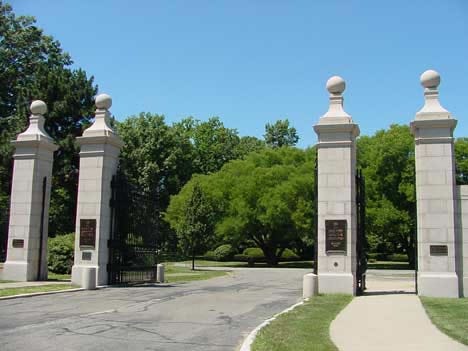



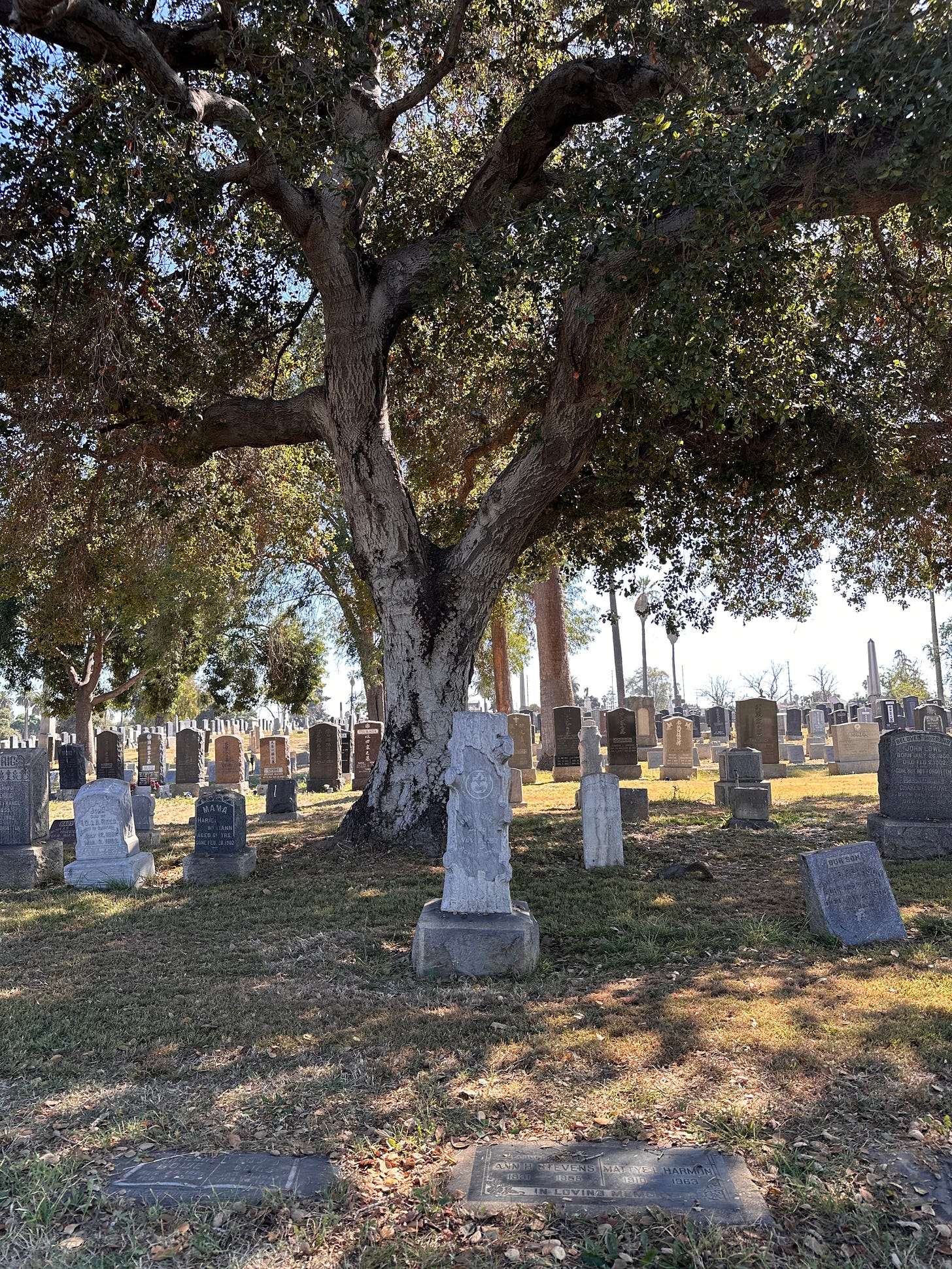
I once dropped a quarter down a hole at the gravestone of a possible relative who died at the bottom of an elevator shaft looking for his lost quarter. https://open.substack.com/pub/johnmoyermedlpcncc/p/episode-8-secrets-from-my-twilight?r=3p5dh&utm_campaign=post&utm_medium=web
I did not know the meaning of a lot of graveyard iconography—so much still to learn!